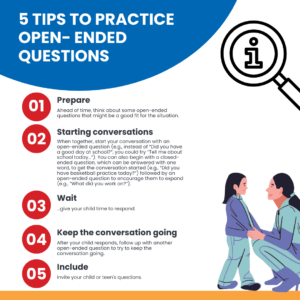Need Something More?
Check out our self-directed Spouse or Significant Other Wellbeing Course.

Communicating about worrisome, sad, or difficult topics can be challenging. Avoiding tough subjects does not help children or teens learn to manage worries and to accept that sad and bad things do happen. Age-appropriate discussions about the PSP job and risks can help children and teens worry less. If your child has concerns, understanding their point of view allows you to problem solve together and provide support. Below are tips for communicating with children and teens, particularly when dealing with difficult subjects.

It is normal for children and teens to worry or have some anxiety. Anxiety becomes a problem if it is intense, happens often, and makes it hard to do everyday activities. If you think that anxiety may be a problem for your child or teen, consult with your primary care provider or a qualified mental health professional.
For more information about anxiety in children and teens, visit:
Open-ended questions or prompts tend to lead to more elaborate responses (not just a yes or no). These questions or statements can begin with how, why, who, what, where, when, or tell me about. Participate in the activity below to see if you can identify open-ended questions.
Using a variety of open-ended questions (or prompts), and waiting for a response, can take practice. During your next one-on-one conversation with your child or teen, try the following:

DOWNLOAD: Tips to Open-ended Questions
Afterward, consider the following: What was it like intentionally using open-ended questions with your child? What did you learn?
Once you have practiced using open-ended questions about everyday situations, begin asking open-ended questions related to PSP work or the lifestyle. The more you practice, the easier the skills of asking open-ended questions and listening will become. This can make it easier to initiate conversations about concerns or difficult topics, when needed.
Reading books or articles can be a great way to share information about PSP work and start conversations with your child or teen. For older children and teens, you may wish to share an age-appropriate article, blog post, or video on a PSP-related topic to provide information and start discussions. For example, you could share a newspaper article and say, “I read this article and was curious about your thoughts on this…” and follow up with an open-ended “What did you think?”
For young children, try the following:
After your shared reading time, reflect on this experience as a family. What was it like to read about the PSP role together? Are there other things you would like to learn about or talk about together?
Below are examples of children’s books about PSP:
Check out our self-directed Spouse or Significant Other Wellbeing Course.
Arruda-Colli, M., Weaver, M. S., & Wiener, L. (2017). Communication about dying, death, and bereavement: A systematic review of children’s literature. Journal of Palliative Medicine, 20(5), 548–559. https://doi.org/10.1089/jpm.2016.0494 ;
Carrico, C. P. (2012). A look inside firefighter families: A qualitative study. ProQuest Dissertations Publishing.
Cox, M., Norris, D., Cramm, H., Richmond, R., & Anderson, G. S. (2022). Public safety personnel family resilience: a narrative review. International Journal of Environmental Research and Public Health, 19(9), 5224. https://doi.org/10.3390/ijerph19095224 ;
Gurwitch, R. (2021). How to talk to children about difficult news. American Psychological Association. Retrieved December 10, 2022, from https://www.apa.org/topics/journalism-facts/talking-children
Kolucki, B., & Lemish, D. (2011). Communication with children: Principles and practices to nurture, inspire, excite, educate and heal. UNICEF. Retrieved December 10, 2022, from https://www.comminit.com/global/content/communicating-children-principles-and-practices-nurture-inspire-excite-educate-and-heal
Traub, S. (2016). Communicating effectively with children. University of Missouri Extension. Retrieved December 10, 2022, from https://extension.missouri.edu/media/wysiwyg/Extensiondata/Pub/pdf/hesguide/humanrel/gh6123.pdf
Walker, J. R., & McGrath, P. (2013). Coaching for confidence workbook. Anxiety Disorders Association of Manitoba.
Wasik, B. A., & Hindman, A. H. (2013). Realizing the promise of open-ended questions. The Reading Teacher, 67(4), 302-311. https://doi.org/10.1002/trtr.1218